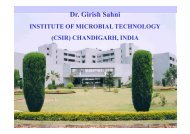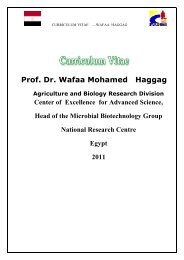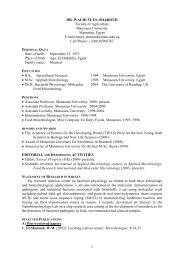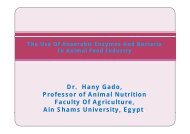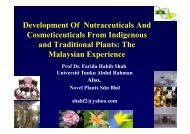Presentation
Presentation
Presentation
Create successful ePaper yourself
Turn your PDF publications into a flip-book with our unique Google optimized e-Paper software.
In vitro Production of Indole Alkaloids from two Egyptian<br />
Catharanthus roseus cultivars by means of<br />
Biotechnology. gy<br />
Prof. Mohamed M. Yacout<br />
Department of Genetics & Biotechnology<br />
Faculty y of Agriculture g ‐ Alexandria Universityy
pharmaceuticals agrochemicals<br />
colors<br />
flavors fragrances<br />
secondary<br />
metabolites<br />
food additives<br />
MAN KIND AND PLANTS<br />
biopesticides
IIn EEgypt, there h are more than h 835<br />
pharmaceuticals and food companies<br />
ALEXREP2009<br />
I In vitro it PProduction d ti of f<br />
Pharmaceutical Plant Products<br />
By means of Biotechnology
Project Partners<br />
1 .Faculty of Agriculture.<br />
Alexandria University<br />
2 .Faculty of Pharmacy.<br />
Alexandria University<br />
3. High institute of health.<br />
Alexandria Alexandria University<br />
4. Mubarak City for Scientific<br />
Research
Catharanthus roseus (Madagascar Periwinkle)<br />
Produce a wide range of secondary metabolites<br />
Aj Ajmalicine li i and d SSerpentine ti – hhypertension t i<br />
Vinblastine and Vincristine – anticancer drugs used<br />
to treat lymphomas y p and leukemia<br />
vinblastine vincristine
Objectives of the project<br />
study DNA<br />
markers related to<br />
Vincristine<br />
production<br />
To produce in<br />
vitro, C. roseus<br />
in plant cell<br />
cultures from<br />
local plants<br />
d ti varieties<br />
to enhance<br />
production, both<br />
in quality and<br />
quantity of<br />
Vincristine<br />
to optimize plant<br />
cell cultures<br />
growth conditions<br />
for Vincristine<br />
production
Objectives of the project<br />
study DNA TTo produce d iin vitro, it<br />
C. roseus in plant<br />
cell cultures from<br />
local plants varieties<br />
markers related<br />
to Vincristine<br />
production<br />
to enhance<br />
production, d i both b h<br />
in quality and<br />
quantity of<br />
Vi Vincristine<br />
i ti<br />
to optimize plant<br />
cell cultures<br />
growth conditions<br />
for Vincristine<br />
production
Objectives of the project<br />
study DNA<br />
markers related to<br />
Vincristine<br />
production<br />
to enhance<br />
production,<br />
both in quality<br />
and quantity<br />
of Vincristine<br />
To produce in<br />
vitro, Vincristine in<br />
plant cell cultures<br />
from local plants<br />
varieties<br />
to optimize plant<br />
cell ll cultures l<br />
growth conditions<br />
for Vincristine<br />
production
Objectives of the project<br />
study DNA<br />
markers<br />
related to<br />
Vincristine<br />
production varieties<br />
To produce in<br />
vitro, Vincristine in<br />
plant cell cultures<br />
from local plants<br />
varieties<br />
to enhance to optimize plant<br />
production, d i bboth hiin<br />
cell ll cultures l<br />
quality and growth conditions<br />
quantity of for Vincristine<br />
Vincristine<br />
production
MATERIALS<br />
AND<br />
METHODS
Two Egyptian<br />
cultivars ii.e. e Pink<br />
and white winkle.
RESULTS
Cell suspension culture<br />
Cell Cell suspension from leaf explants in MS media media
Cell suspension from leaf explants in MS<br />
media
Figure 1: Callus shape at 10 x power in binocular<br />
microscope formed from leaf explants of C roseus
Figure 2: Induced callus percentage from leaf explants on MS<br />
media with 1-Naphthyl acetic acid (NAA) and kinetin (Kin).
2,4-Dichlorophenoxy<br />
acetic acid (2,4-D)<br />
concentration mg/l<br />
mg/l<br />
2,4 4D1,5<br />
2,4 2,4 4D1<br />
2,4D .5<br />
IAA IAA AA.5 AA.5<br />
IAA1 IAA1 A1 A1<br />
IAA1.5 IAA1.5 .5 .5<br />
90<br />
80<br />
70<br />
60<br />
50 Callus formation<br />
40 percentage<br />
30<br />
20<br />
10<br />
0<br />
Indole 3-acetic acid (IAA) ( )<br />
concentration mg/L<br />
Figure 3: Callus formation percentage from leaf explants on MS media with<br />
2,4-Dichlorophenoxy acetic acid (2,4-D) and Indole 3-acetic acid (IAA).
Cell culture<br />
fresh weight<br />
(g/L)<br />
6<br />
5<br />
4<br />
3<br />
2<br />
1<br />
0<br />
8000<br />
7000<br />
6000<br />
5000<br />
4000<br />
3000<br />
2000<br />
1000<br />
0<br />
N1.5Kin0.5 N0.5Kin0.5 2D1IA0.5 2D1IA1 2D1IA1.5 2D1.5IA0.5 2D1.5IA1 2D1.5IA1.5<br />
2,4 D, NAA, IAA concentrations mg/L<br />
Figure 4: Fresh weight of cells yield of cell suspension from leaf<br />
explants in MS media with 2,4-Dichlorophenoxy acetic acid (2,4-<br />
D), 1-Naphthyl acetic acid (NAA) and/or kinetin (Kin).
Production of alkaloids<br />
Applying TLC technique for extracts of Alkaloids from<br />
cells and callus showed that there was difference<br />
between pink and white plants in types and quantity.<br />
Pink plants cells and callus gave two types of spots<br />
on TLC plates while white plants gave one spot.<br />
Thee intensity e s y of o theespots spo s which c reflect e ec thee<br />
concentration was darker in case of pink plants more<br />
than white ones. On the other hand, , callus spots p<br />
were stronger than that of cells.<br />
•<br />
•<br />
•
Objectives of the project<br />
study DNA<br />
markers related to<br />
Vincristine<br />
production<br />
To produce in<br />
vitro, C. roseus<br />
in plant cell<br />
cultures from<br />
local plants<br />
d ti varieties<br />
to enhance<br />
production, both<br />
in quality and<br />
quantity of<br />
Vincristine<br />
to optimize plant<br />
cell cultures<br />
growth conditions<br />
for Vincristine<br />
production
Dr Fathy El-Fiky &<br />
Dr Hattem Meky<br />
Department of Pharmacognosy,<br />
Pharmacognos<br />
Faculty of Pharmacy,<br />
Alexandria University<br />
Dr. Wafaa Masoud<br />
Biotechnology laboratory,<br />
Faculty of Agriculture,<br />
Alexandria University<br />
From our group<br />
Thanks to:
In vitro Production of Indole Alkaloids from two<br />
Egyptian Catharanthus roseus cultivars by means<br />
of Biotechnology<br />
Biotechnology.<br />
Mohamed M. Yacout,* Fathy El‐Fiky,*** Hattem Mekky*** and Wafaa M. Masoud**<br />
*Department of Genetics and biotechnology, biotechnology Faculty of Agriculture, Agriculture Alexandria University<br />
** Biotechnology laboratory, Faculty of Agriculture, Alexandria University<br />
***Department of Pharmacognosy, Faculty of Pharmacy, Alexandria University<br />
(Email (<br />
to: mohamed.yakout@alex<br />
y<br />
‐ agr.edu.eg g g )
In vitro Production of Indole Alkaloids from two<br />
Egyptian Catharanthus roseus cultivars by means<br />
of Biotechnology<br />
Biotechnology.<br />
Mohamed M. Yacout,* Fathy El‐Fiky,*** Hattem Mekky*** and Wafaa M. Masoud**<br />
*Department of Genetics and biotechnology, biotechnology Faculty of Agriculture, Agriculture Alexandria University<br />
** Biotechnology laboratory, Faculty of Agriculture, Alexandria University<br />
***Department of Pharmacognosy, Faculty of Pharmacy, Alexandria University<br />
(Email ( to: mohamed.yakout@alex<br />
y<br />
‐ agr.edu.eg g g )<br />
Replay



